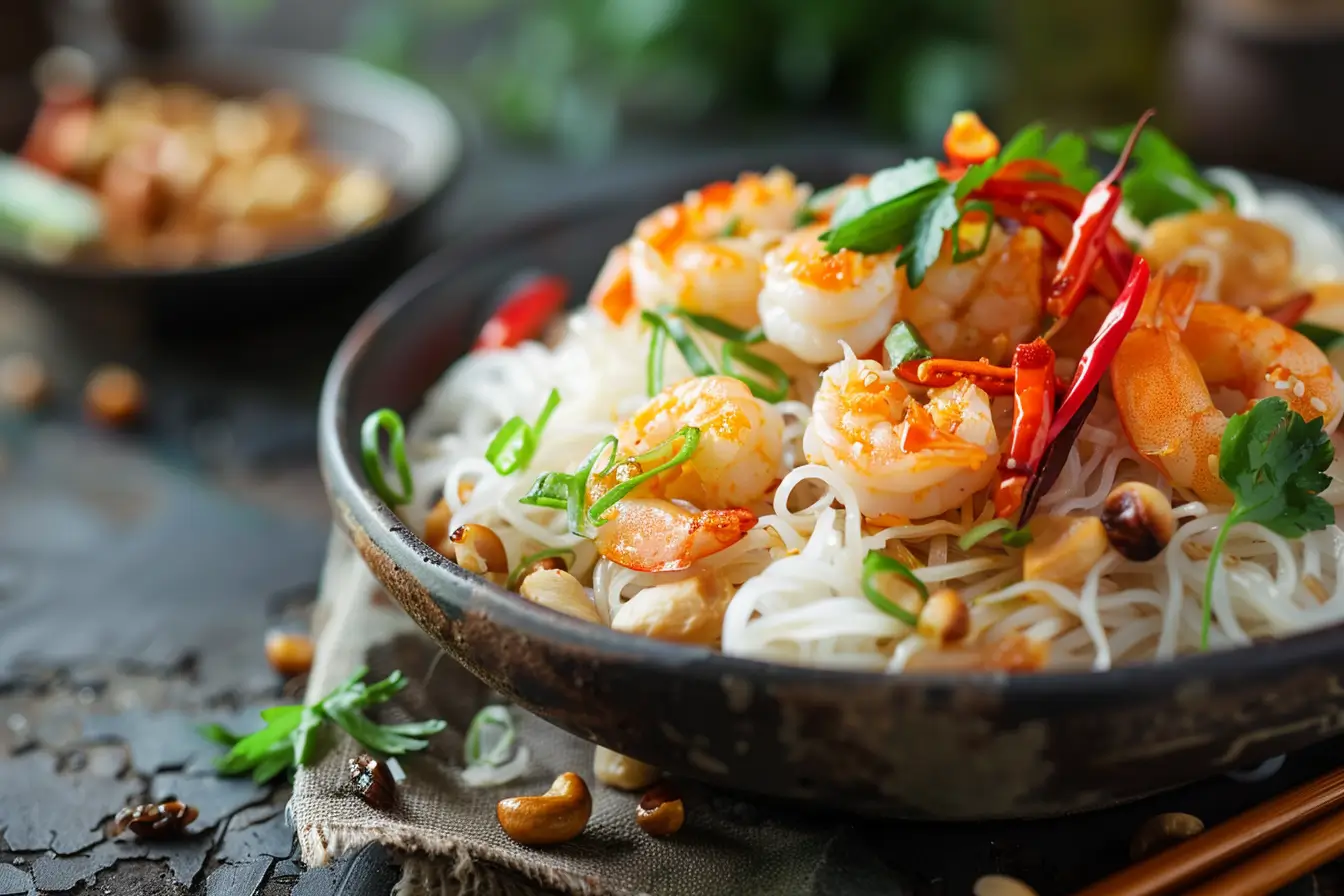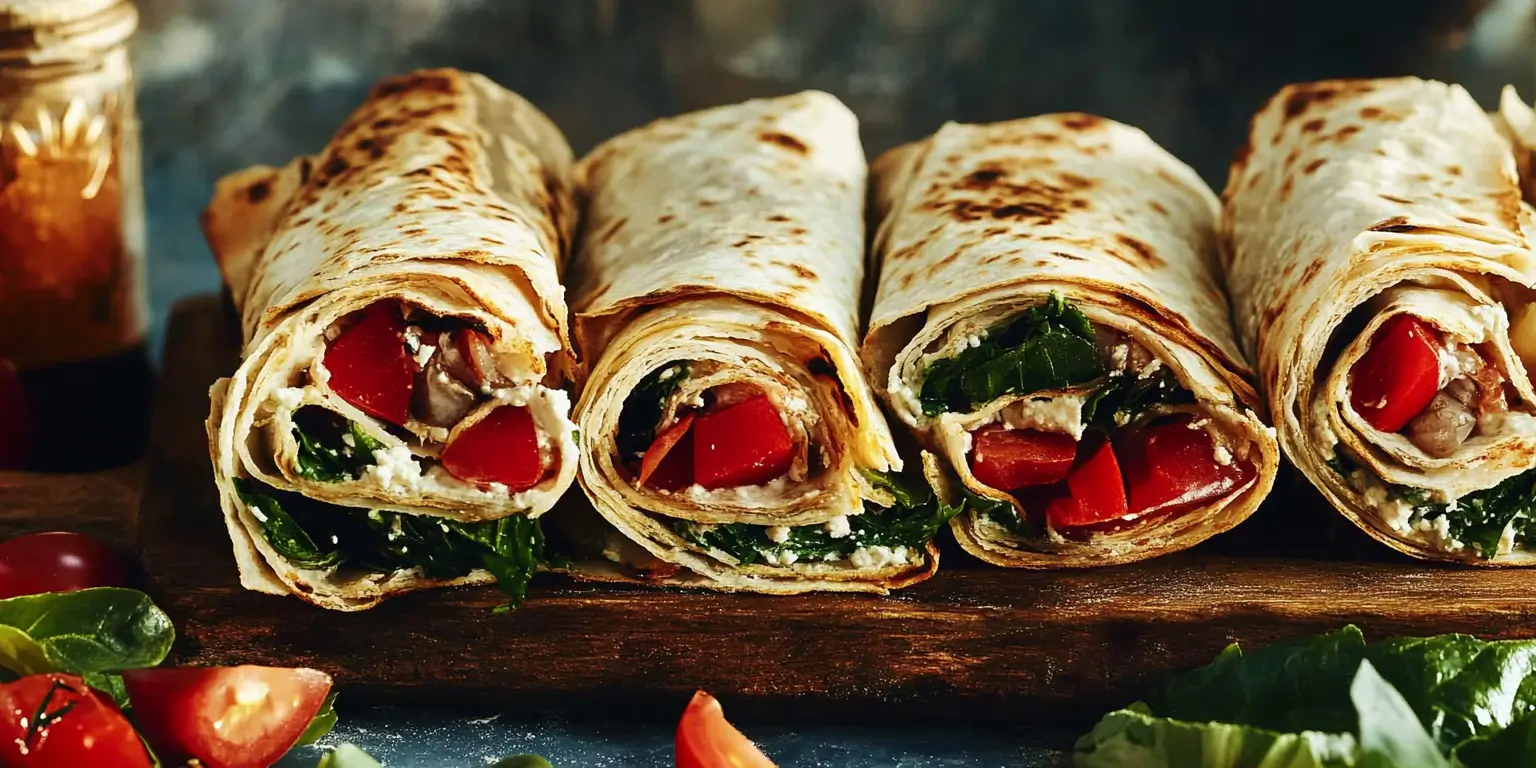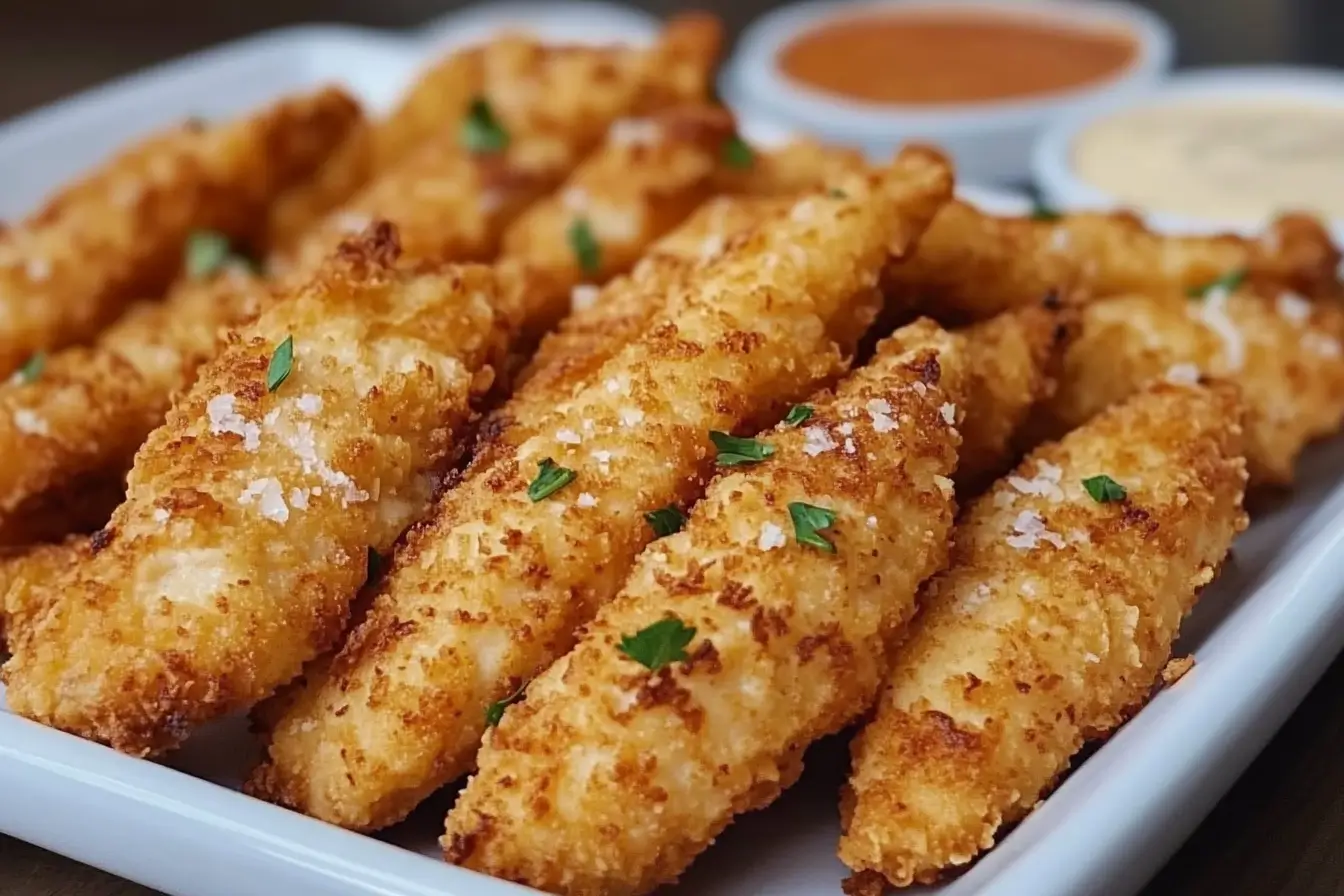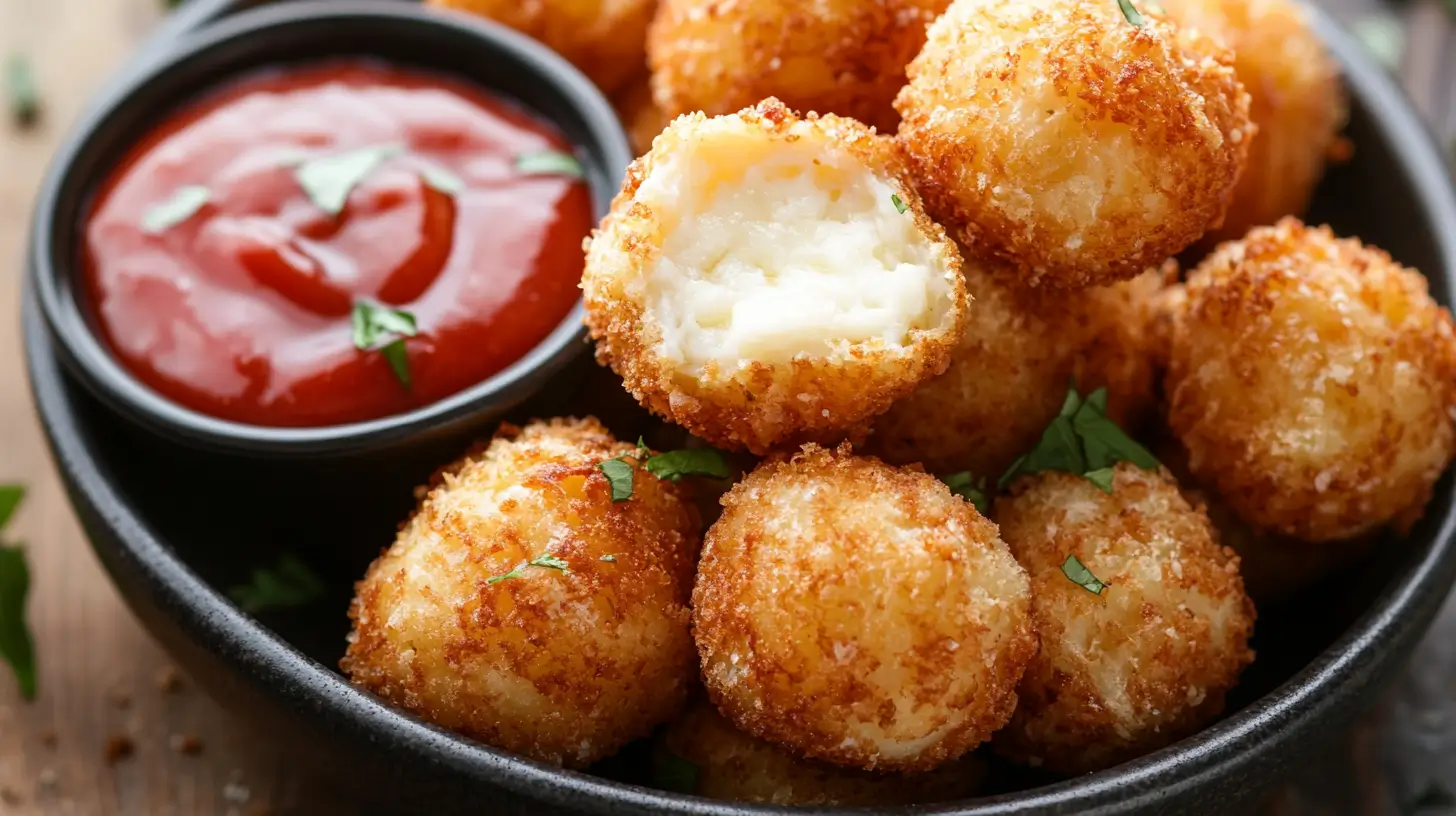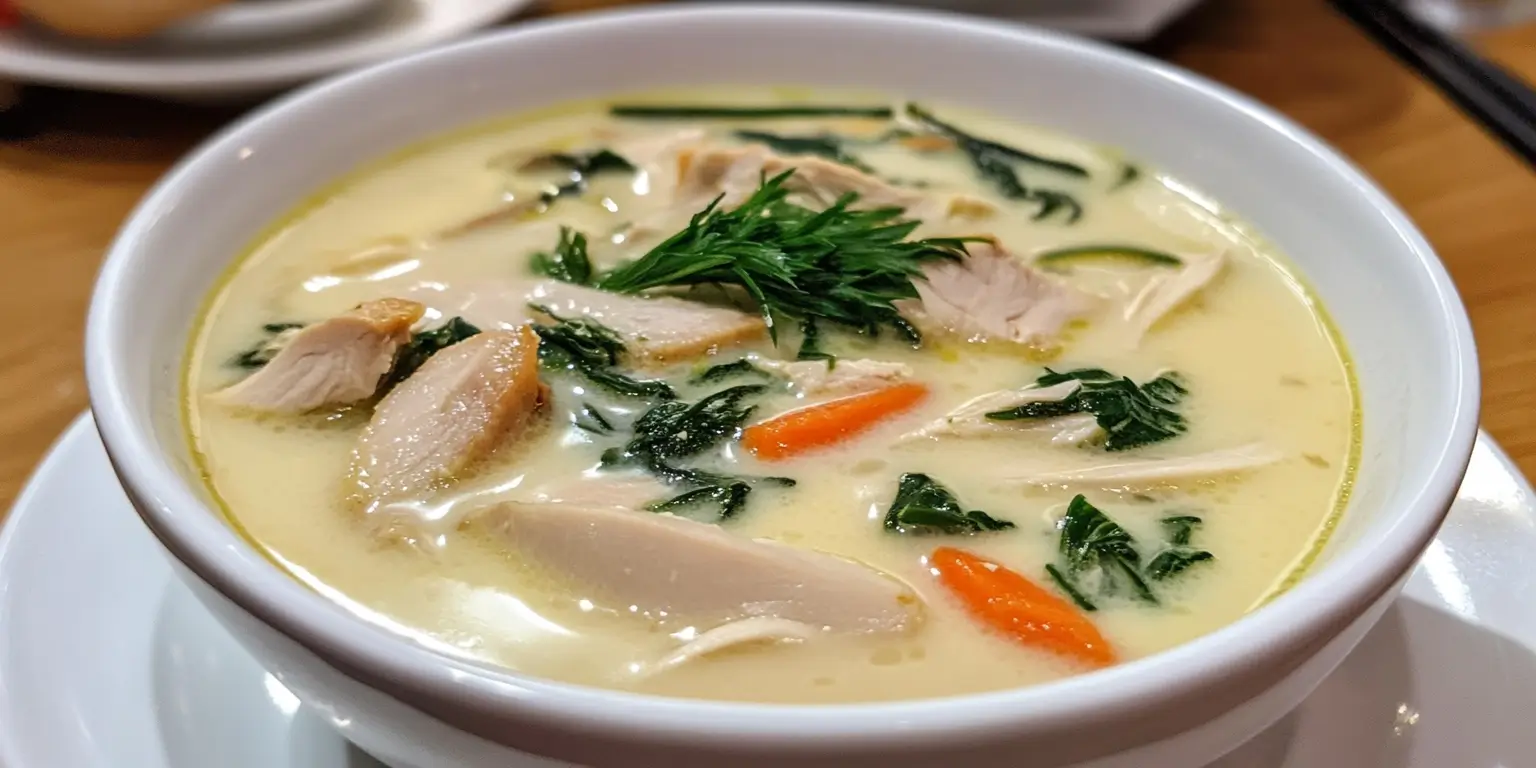Rice noodles have become a staple in many kitchens, celebrated for their versatility, light texture, and suitability for various dietary needs, especially gluten-free diets. This comprehensive guide will delve into everything you need to know about rice noodles—from their nutritional benefits to the best cooking methods, and even some popular dishes. Whether you’re a novice cook or a seasoned chef, this article will provide valuable insights to enhance your culinary skills with rice noodles.
What Are Rice Noodles?
Rice noodles, a beloved ingredient in many Asian cuisines, are made from rice flour and water. They come in various shapes and sizes, perfect for different types of dishes.
Definition and Origin of Rice Noodles
Rice noodles originated in Asia, with their roots tracing back to Chinese and Southeast Asian culinary traditions. They have since spread globally, becoming a popular choice for many.
Types of Rice Noodles
Rice noodles come in several forms, including thin vermicelli, wide flat noodles, and even rolled varieties. Each type offers a unique texture and is suited to specific dishes.
Rice noodles are versatile, used in soups, stir-fries, and salads. They absorb flavors well, making them a great base for many recipes.
Nutritional Benefits
Before diving into the specifics of how to cook rice noodles, it’s essential to understand their nutritional benefits. This part will highlight why rice noodles are considered a healthy choice compared to other types of noodles.
Are Rice Noodles Healthier?
Rice noodles are often touted as a healthier alternative to traditional wheat-based noodles. Let’s explore the reasons behind this claim.
Comparison with Other Types of Noodles
When compared to wheat noodles, rice noodles are lower in calories and fat. They are also naturally gluten-free, making them suitable for those with gluten intolerance or celiac disease.
Health Benefits of Rice Noodles
Rice noodles are light and easy to digest, which can be beneficial for those with sensitive digestive systems. They are also low in fat and calories, helping in weight management and overall health.
These nutritional advantages make rice noodles a great option for a balanced diet. They offer essential nutrients while being light on the stomach.
Rice Noodles vs. Pasta
Next, we’ll compare rice noodles to pasta, highlighting why many people prefer rice noodles. This comparison will cover aspects like texture, taste, and nutritional value.
Why Are Rice Noodles Better Than Pasta?
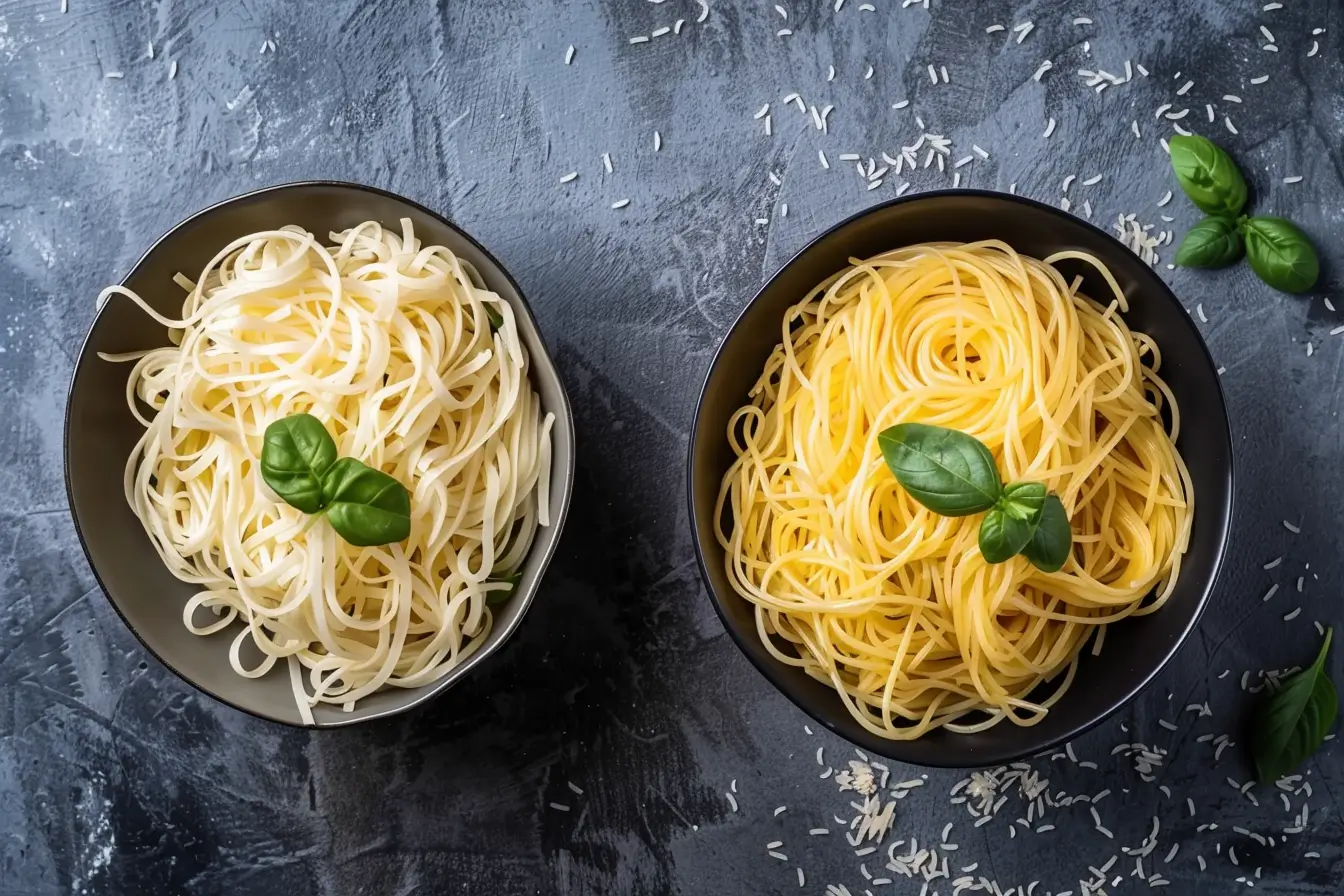
Many people choose rice noodles over pasta for various reasons. Let’s delve into why rice noodles might be the better option for you.
Texture and Taste Comparison
Rice noodles have a unique texture that is both light and slightly chewy. This makes them perfect for absorbing flavors in soups and stir-fries. In contrast, pasta tends to be denser and heavier.
Nutritional Comparison
One of the main reasons rice noodles are preferred is their nutritional profile. They are gluten-free, making them a safe choice for those with gluten sensitivities. Additionally, rice noodles typically have fewer calories and carbohydrates than pasta, making them a healthier option.
Choosing rice noodles over pasta can be a delightful change, offering a different texture and taste while being lighter on the stomach.
Cooking Rice Noodles
Cooking rice noodles can be straightforward, but there are specific techniques to ensure they turn out perfect every time. This part will provide a step-by-step guide and helpful tips.
What Is the Best Way to Cook Rice Noodles?
Cooking rice noodles properly can make a significant difference in your dishes. Let’s go through the best methods to achieve perfectly cooked rice noodles.
Step-by-Step Cooking Guide
- Soak the Noodles: Begin by soaking dry rice noodles in warm water for about 10-15 minutes, or until they become pliable but not too soft.
- Boil: Bring a pot of water to a boil, then add the soaked noodles. Boil for 2-3 minutes, depending on the thickness of the noodles.
- Drain and Rinse: Drain the noodles and rinse them under cold water to stop the cooking process and remove excess starch.
Tips and Tricks for Perfect Rice Noodles
- Avoid Overcooking: Rice noodles can become mushy if overcooked. Always follow the recommended cooking times.
- Use Immediately: For the best texture, use the noodles immediately after cooking. If you need to store them, toss them in a bit of oil to prevent sticking.
By following these steps, you’ll ensure your rice noodles are always cooked to perfection.
Gluten-Free Diet
For those with gluten sensitivities or celiac disease, rice noodles offer a safe and delicious alternative to traditional wheat-based noodles. This part will delve into the gluten-free benefits of rice noodles.
Are Rice Noodles Gluten-Free?
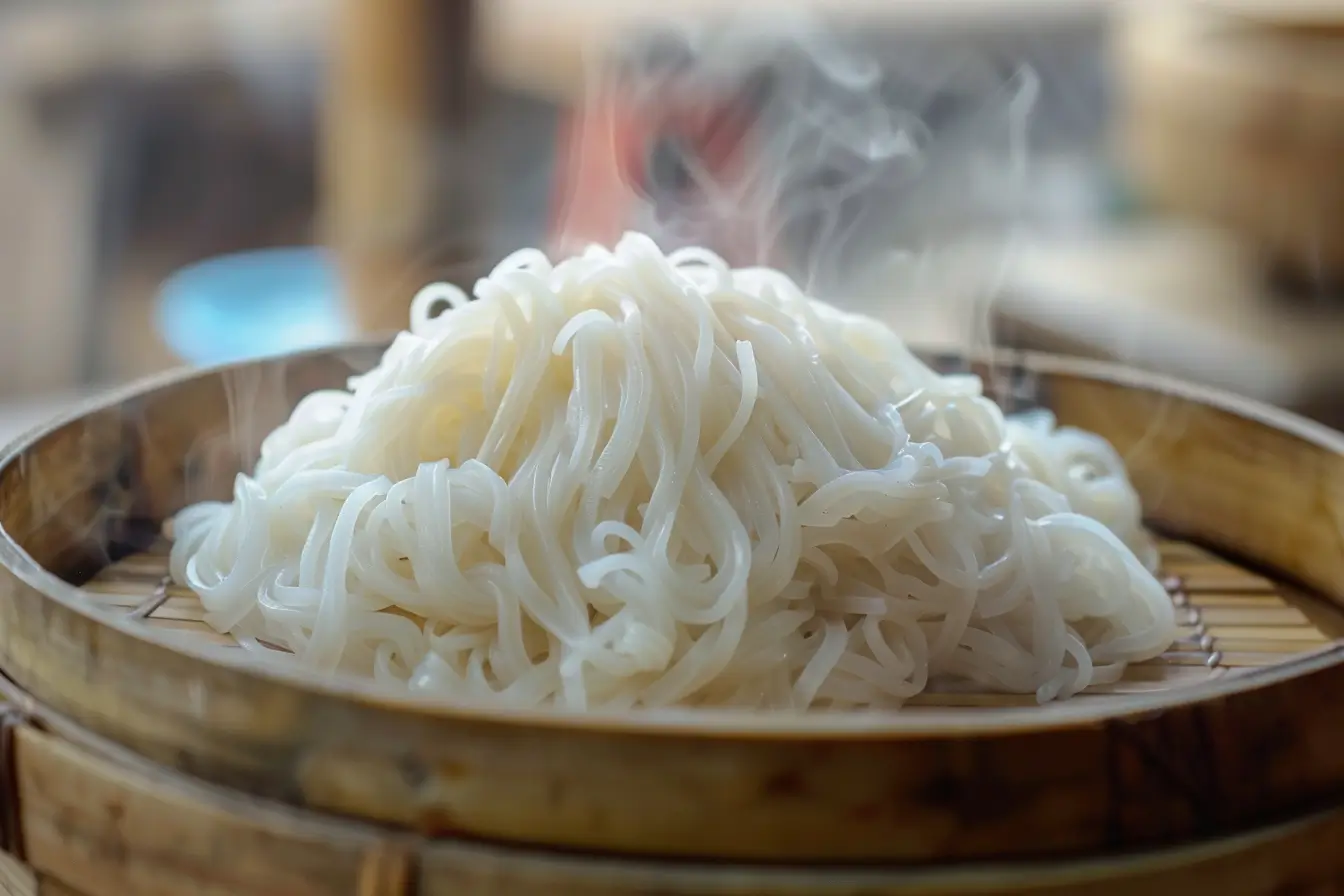
Rice noodles are naturally gluten-free, making them an excellent choice for individuals who need to avoid gluten. Let’s explore why they are beneficial for a gluten-free diet.
Explanation of Gluten and Gluten-Free Diets
Gluten is a protein found in wheat, barley, and rye. Many people cannot digest gluten properly, leading to health issues like celiac disease or gluten intolerance. A gluten-free diet excludes all sources of gluten, requiring alternative options like rice noodles.
Benefits of Rice Noodles for Gluten-Free Diets
Rice noodles are made from rice flour and water, ensuring they are free from gluten. This makes them ideal for those who must adhere to a strict gluten-free diet, providing a safe and tasty option.
By incorporating rice noodles into your meals, you can enjoy a variety of dishes without worrying about gluten. Next, we’ll look at some popular rice noodle dishes in part 6.
Popular Rice Noodle Dishes
Rice noodles are a versatile ingredient used in many delicious dishes worldwide. This part will introduce some of the most popular rice noodle dishes and their cultural significance.
Popular Rice Noodle Dishes
Rice noodles are the star ingredient in many beloved dishes across different cultures. Let’s explore some of these popular dishes.
Pho
Pho is a traditional Vietnamese soup featuring a savory broth, rice noodles, fragrant herbs, and either beef or chicken. It’s a flavorful and comforting dish that has gained international popularity.
Pad Thai
Pad Thai is a famous Thai stir-fry dish made with rice noodles, shrimp or chicken, eggs, and a mix of vegetables. It’s seasoned with tamarind paste, fish sauce, and chili, offering a perfect balance of sweet, sour, and spicy flavors.
These dishes highlight the versatility and cultural richness of rice noodles. They are perfect for anyone looking to explore new flavors and culinary traditions. Next, let’s discuss how to buy and store rice noodles in part 7.
Buying and Storing Rice Noodles
Understanding how to buy and store rice noodles properly ensures you always have fresh, high-quality noodles on hand. This part will provide tips on purchasing and storing rice noodles.
Buying and Storing Rice Noodles
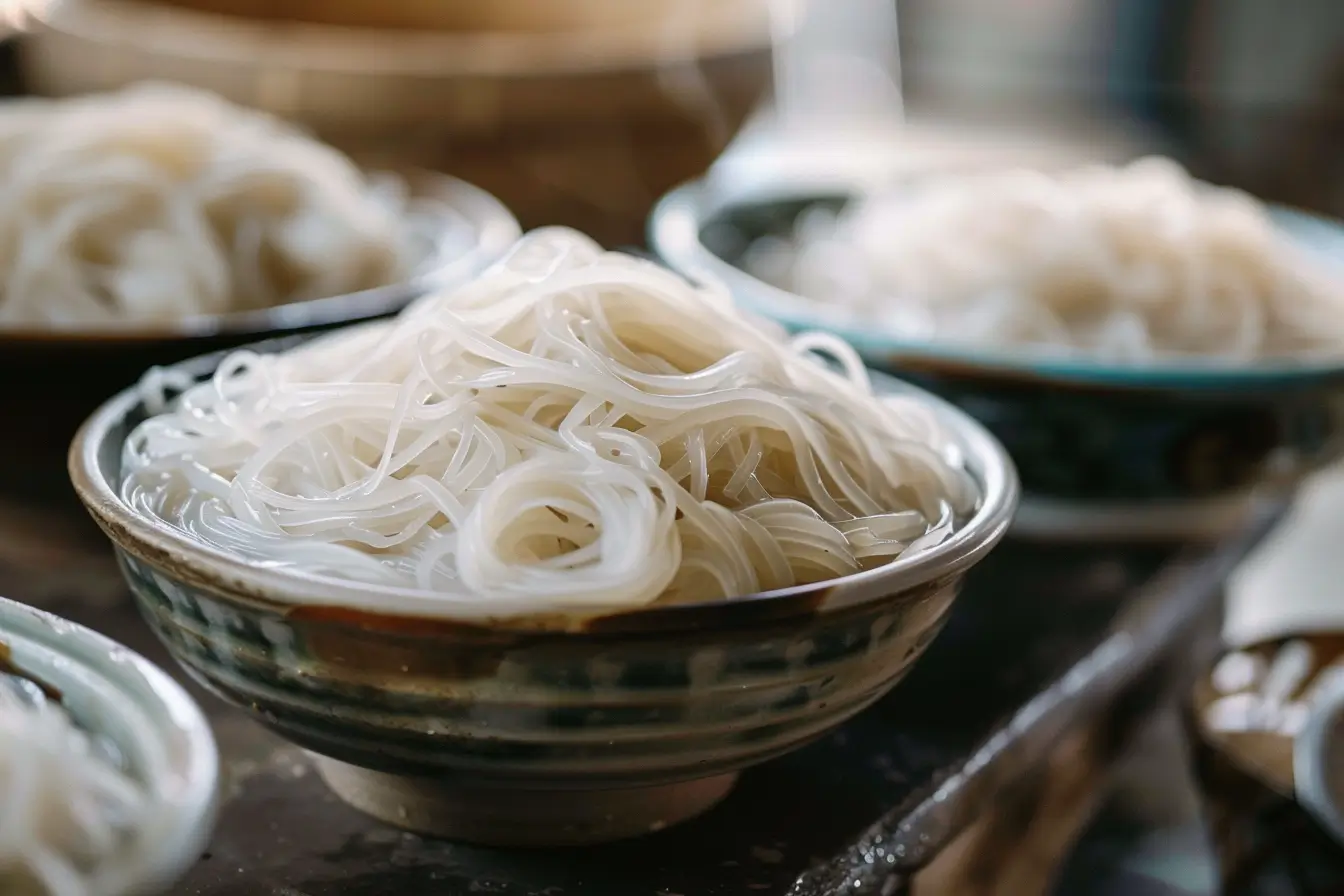
To enjoy the best taste and texture, it’s crucial to know how to select and store rice noodles correctly.
Tips for Purchasing Rice Noodles
When buying rice noodles, look for brands that use high-quality ingredients. Check the packaging for freshness and avoid noodles that appear broken or have an unusual odor. Popular brands can be found in Asian markets and the international aisle of most grocery stores.
Proper Storage Methods
Store uncooked rice noodles in a cool, dry place, such as a pantry. After opening, store them in an airtight container to keep them fresh. Cooked rice noodles should be refrigerated and used within 3-4 days. To prevent sticking, toss them with a bit of oil before storing.
By following these guidelines, you can ensure your rice noodles remain fresh and ready for your next culinary creation.
Rice noodles are not just for traditional Asian dishes; they can be incorporated into various creative recipes that are both delicious and healthy. This part will explore some inventive ways to use rice noodles in your cooking.
Creative Ways to Use Rice Noodles
Using rice noodles creatively can add a new twist to your meals. Here are some innovative recipes and ideas to inspire you.
Rice Noodle Salad Bowls
Rice noodle salad bowls are a fresh and vibrant way to enjoy this ingredient. These noodles make an excellent choice for a light lunch or a side dish.
Ingredients: Rice noodles, mixed greens, shredded carrots, sliced cucumbers, bell peppers, and your choice of protein (e.g., grilled chicken, tofu, or shrimp).
- Dressing: A tangy sesame dressing made from soy sauce, rice vinegar, sesame oil, and a touch of honey.
- Preparation: Cook the rice noodles and let them cool. Toss them with the vegetables and protein, then drizzle with the dressing. Garnish with sesame seeds and fresh herbs such as cilantro or mint for added flavor.
Rice Noodle Stir-Fry
A quick and easy stir-fry can be a great way to use up leftover vegetables and protein, with rice noodles serving as the perfect base.
- Ingredients: Rice noodles, mixed vegetables (such as broccoli, bell peppers, snap peas), garlic, ginger, soy sauce, and your choice of protein (beef, chicken, tofu).
- Preparation: Cook the rice noodles according to the package instructions. In a large wok or skillet, stir-fry the garlic and ginger until fragrant. Add the vegetables and protein, and cook until tender. Add the cooked noodles and soy sauce, tossing everything together until well combined.
Rice Noodle Soup
A comforting bowl of rice noodle soup can be a perfect meal on a chilly day. It’s also a great way to make use of homemade or store-bought broth.
- Ingredients: Rice noodles, chicken or vegetable broth, sliced mushrooms, bok choy, green onions, and your choice of protein.
- Preparation: Bring the broth to a boil and add the mushrooms and bok choy. Cook until the vegetables are tender. Add the rice noodles and protein, and cook until everything is heated through. Garnish with green onions and a squeeze of lime.
These creative uses of rice noodles showcase their versatility and ability to adapt to different flavors and cuisines.
Tips and Tricks for Perfect Rice Noodle Dishes
Perfecting your rice noodle dishes involves more than just following a recipe. This part will provide additional tips and tricks to ensure your rice noodle dishes are always a hit.
Tips and Tricks for Perfect Rice Noodle Dishes
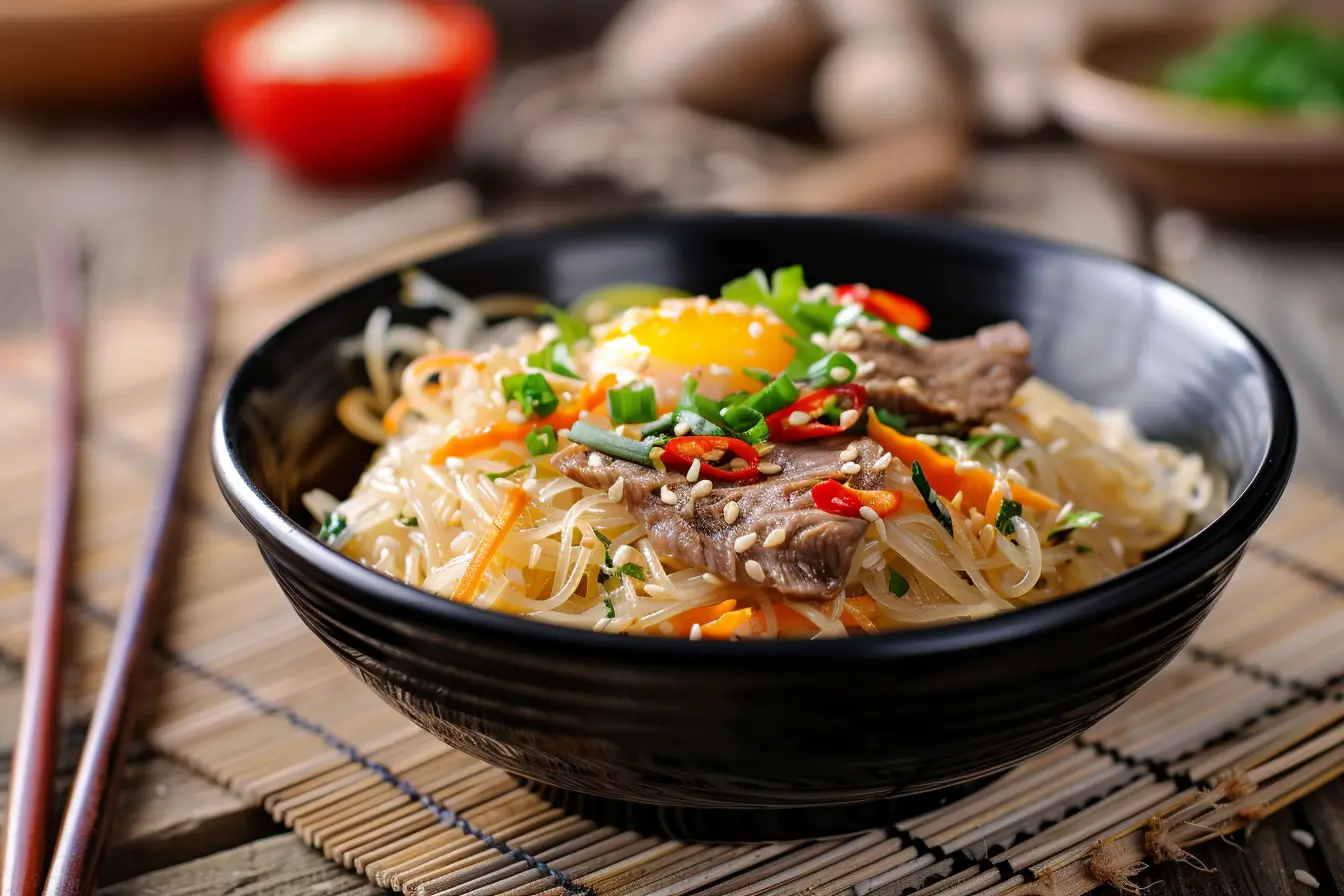
Enhance your rice noodle cooking skills with these practical tips and tricks. They will help you achieve the perfect texture and flavor every time.
Avoid Overcooking
Overcooking rice noodles is a common mistake that can result in a mushy texture. Here’s how to avoid it:
- Soaking Time: Always soak the noodles in warm water before boiling them. This helps them cook evenly and prevents them from becoming too soft.
- Cooking Time: Boil the noodles for the shortest time possible, usually 2-3 minutes. Keep a close eye on them and taste test frequently to ensure they are al dente.
Rinse After Cooking
Rinsing rice noodles after cooking helps remove excess starch and stops the cooking process. This trick can improve the texture and prevent the noodles from sticking together.
- Cold Water Rinse: After boiling, drain the noodles and rinse them under cold water. Toss them gently to ensure all noodles are rinsed thoroughly.
- Toss with Oil: If you’re not using the noodles immediately, toss them with a small amount of oil to prevent sticking.
Flavor Absorption
Rice noodles are excellent at absorbing flavors, which can enhance the overall taste of your dish.
- Marinate Noodles: Before adding them to stir-fries or soups, marinate the noodles in a mixture of soy sauce, sesame oil, and your favorite spices. This will infuse them with more flavor.
- Add to Broth: When making soups, add the rice noodles last to allow them to soak up the broth’s flavors without becoming too soft.
Storing Leftovers
Storing cooked rice noodles properly can extend their shelf life and maintain their quality.
- Refrigeration: Place cooked noodles in an airtight container and refrigerate for up to 3-4 days. Before reheating, add a splash of water to help loosen them up.
- Freezing: If you need to store them longer, you can freeze rice noodles. Portion them into freezer-safe bags and remove as much air as possible. Reheat them directly from frozen, adding them to boiling water for a quick refresh.
These tips and tricks will help you master the art of cooking with rice noodles, ensuring your dishes are always delicious and well-prepared.
[tasty-recipe id=”714″]
FAQs About Rice Noodles
Here are some frequently asked questions about rice noodles to help you better understand and enjoy this wonderful ingredient.
Are Rice Noodles Healthier?
Rice noodles are often considered healthier than traditional wheat noodles because they are lower in calories and fat. They are also gluten-free, making them suitable for people with gluten sensitivities or celiac disease.
Why Are Rice Noodles Better Than Pasta?
Rice noodles have a lighter texture and are easier to digest compared to pasta. They are also gluten-free, which makes them an excellent alternative for those avoiding gluten.
What Is the Best Way to Cook Rice Noodles?
The best way to cook rice noodles is to soak them in warm water until pliable, then boil them for a few minutes until tender. Avoid overcooking to prevent them from becoming mushy.
Are Rice Noodles Gluten-Free?
Yes, rice noodles are naturally gluten-free. They are made from rice flour and water, making them a safe option for individuals with gluten intolerance or celiac disease.
- How to reheat rice noodles without them becoming mushy? Reheat rice noodles by briefly soaking them in hot water or microwaving them with a damp paper towel.
- Can rice noodles help with weight loss? Rice noodles can be part of a weight loss diet due to their low-calorie and low-fat content.
In this final part, we will summarize the key points discussed in the article and encourage readers to try incorporating rice noodles into their diet.
Conclusion
Rice noodles are a versatile and nutritious ingredient that can elevate a variety of dishes. Their unique texture, gluten-free nature, and ease of cooking make them a favorite among many.
Key Takeaways
- Versatility: Rice noodles can be used in soups, stir-fries, and salads, making them a staple in many cuisines.
- Health Benefits: They are low in calories and fat, gluten-free, and easy to digest.
- Cooking Tips: Proper soaking and boiling techniques ensure perfect rice noodles every time.
- Popular Dishes: Pho and Pad Thai are just two examples of delicious dishes you can create with rice noodles.
Incorporating rice noodles into your meals can be a delightful way to enjoy healthy and flavorful dishes. They are easy to prepare and can fit into various dietary preferences.
For more recipes and tips, you might want to check out these resources:
- Healthline – Benefits of a Gluten-Free Diet
- Bon Appetit – Classic Pad Thai Recipe
- The Spruce Eats – Easy Pho Soup Recipe
By following the tips and insights shared in this guide, you can master the art of cooking with rice noodles and enjoy their numerous benefits.

